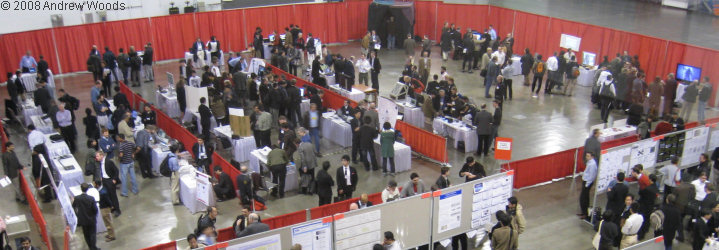|
[1] A view of part of the demonstration session in action.
The following items were on display at the 2008 demonstration session:
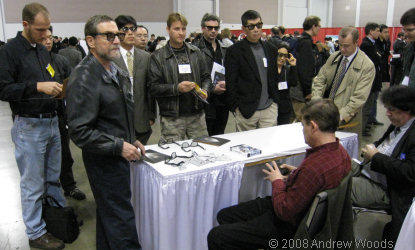 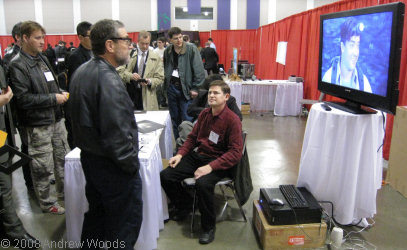
| |
[2a,2b] Brad Nelson and David Mark from Kerner Optical Research and Development (KORD) (San Rafael, California) demonstrated the new SpectronIQ 46" 3D Full-HD (1920x1080) LCD HDTV (Model number IQ3D-A46), which was viewed using circularly polarized 3D glasses. 3D content shown on the display included the 3D trailer for the upcoming 3D movie, "Journey to the Center of the Earth 3D."
|
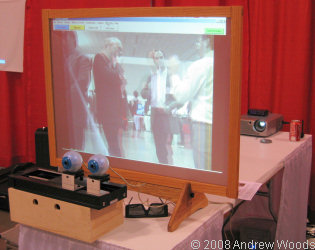 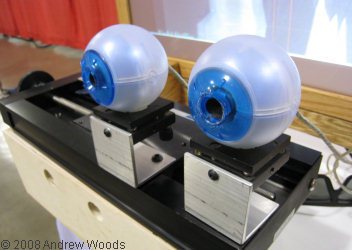 | |
[3a, 3b] Chris Ward and Bob Mueller from Lightspeed Design (Bellevue, Washington) demonstrated a custom version of DepthQ Capture software for the analysis, optimization and correction of 3D HD video content from stereoscopic camera rigs. Hardware used included a DepthQ 3D projector, rear-projection screen, an eyeball- like stereoscopic camera pair, and NuVision cinema LCS (Liquid Crystal Shutter) 3D glasses.
|
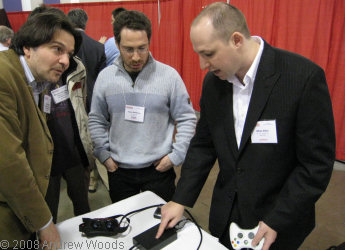 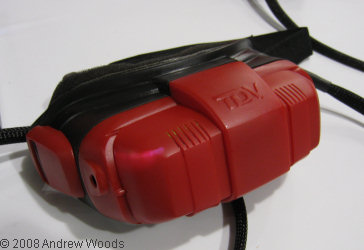
| |
[4a,4b] Ethan Schur from TDVision Systems (Naperville, Illinois) demonstrated the TDVisor, a stereoscopic head-mounted display (HMD) with 800x600 resolution. Content shown on the display included a navigable stereoscopic virtual world and portals to show a selection of stereoscopic videos. A 2D projector was setup to allow the attendees to see what the person wearing the TDVisor could see. (Pictured: Massimo Sabbatini, Jason Goodman, Ethan Schur)
|
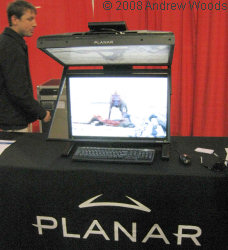 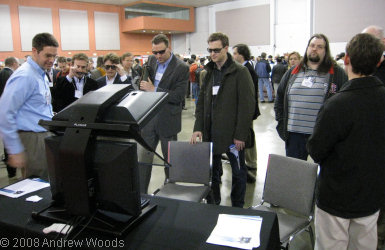
| |
[5a,5b] Scott Robinson from Planar Systems (Beaverton, Oregon) demonstrated the SD2420W StereoMirror display, which has 1920x1200 stereoscopic resolution with a 24" diagonal screen size and is viewed with passive polarized 3D glasses.
|
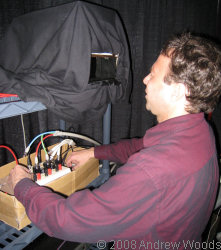 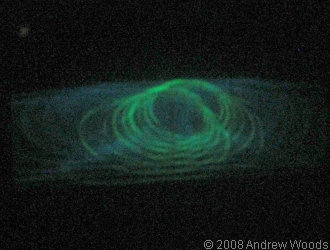 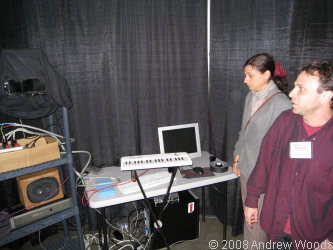
| |
[6a,6b,6c] Walter Funk from Hologlyphics (Oakland, California) demonstrated a small true 3D display showing stereoscopic animations in synchronization with live performed music.
|
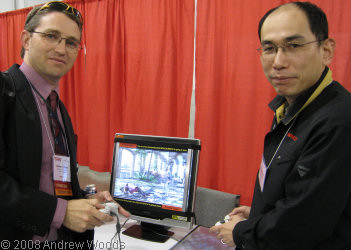 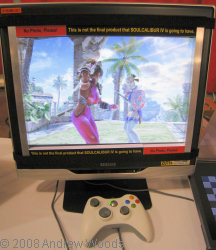 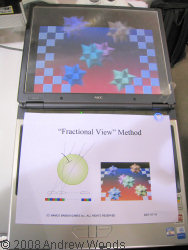
| |
[7a,7b,7c] Atsushi Miyazawa and Motonaga Ishii from Namco Bandai Games (Tokyo, Japan) demonstrated a special 3D display non-production version of SOULCALIBUR IV on the Xbox 360 game platform connected to a multiview autostereoscopic display. (Pictured: Andrew Woods and Motonaga Ishii)
|
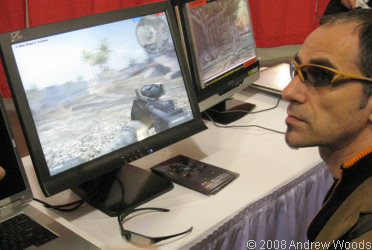 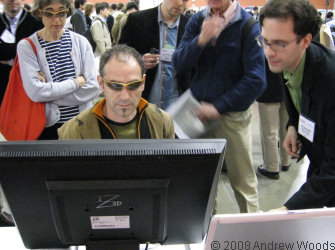
| |
[8a, 8b] Neil Schneider from Meant to be Seen (Toronto, Canada) demonstrated several production games running in stereoscopic mode using the iZ3D stereoscopic game driver and shown on a 22" iZ3D stereoscopic monitor. The monitor was viewed using passive polarized 3D glasses and had a stereoscopic resolution of 1680x1050 per eye.
|
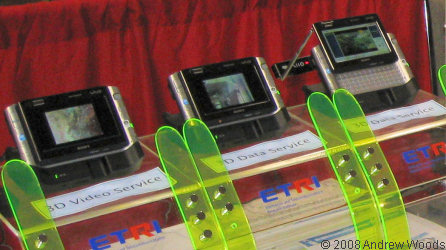 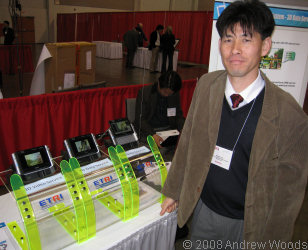
| |
[9a,9b] Jinwoong Kim and staff from Electronics and Telecommunications Research Institute (ETRI) (Daejeon, South Korea) demonstrated a complete 3D DMB (digital multimedia broadcast) system for wide-area broadcast of stereoscopic content to handheld consumer devices with an in-built two-view autostereoscopic display. The system components on show included a stereoscopic 3D video transmitter and a selection of UMPC (ultra-mobile personal computer) mobile devices - all capable of receiving and displaying 3D DMB.
|
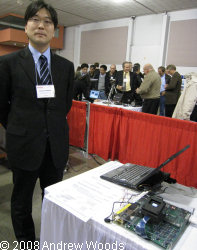 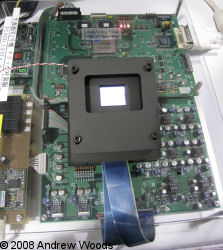 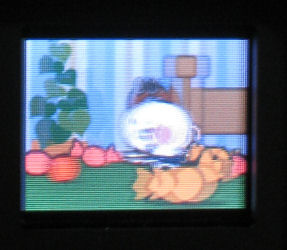
| |
[10a,10b,10c] Shin-ichi Uehara from NEC LCD Technologies (Kanagawa, Japan) demonstrated a 1-inch diagonal Transflective 2D and 3D LCD with HDDP (horizontally double-density pixels) arrangement intended for use on 3D mobile phones. In 3D mode the display was two-view autostereoscopic.
|
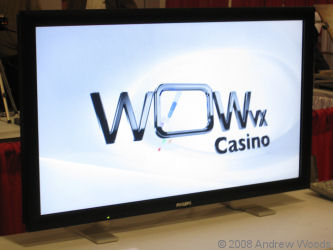 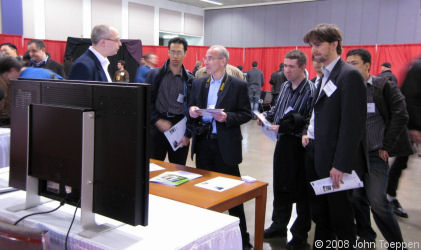
| |
[11a,11b] Robert-Paul Berretty and Bart Barenbrug from Philips 3D Solutions (Eindhoven, Netherlands) demonstrated the 42" WOW multiview autostereoscopic display (model number: 42-3D6W02). 3D content shown on the display included the WOWvx demo shown the previous night in the 3D Theatre session, but in multiview 3D on this display. The display has a base resolution of 1920x1080 and outputs nine views. [photo 11b is also available as a JPS (Stereoscopic JPEG)]
|
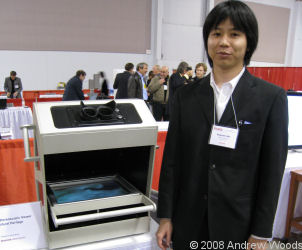 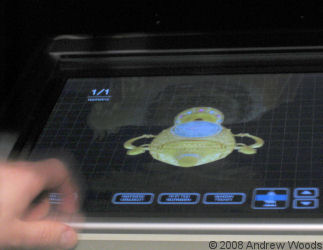 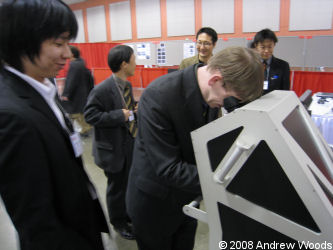
| |
[12a,12b,12c] Nobuaki Abe from Waseda University (Tokyo, Japan) demonstrated an interactive stereoscopic viewer system for cultural heritage. The system consisted of a 3D display using micro-polarizer, a touch-panel, and a tilt encoder and was controlled by a Windows PC with special software.
|
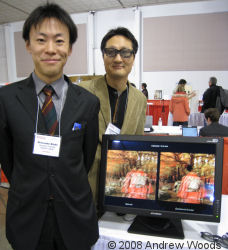
| |
[13a] Shinsuke Kishi from Waseda University (Tokyo, Japan) demonstrated prototype software to correct the parallax of stereoscopic image and video content to provide improved viewing safety and comfort. The software was shown on a 24" Hyundai 3D LCD monitor viewed using circularly polarized 3D glasses.
|
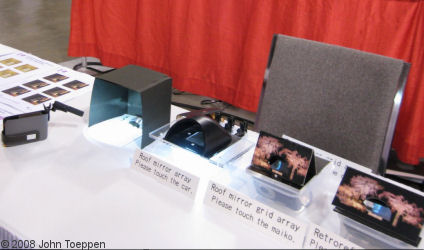
| |
[14a] Satoshi Maekawa from National Institute of Information & Communications Technology (NICT) (Kyoto, Japan) demonstrated several new imaging optics using an array of micro-mirrors.
|
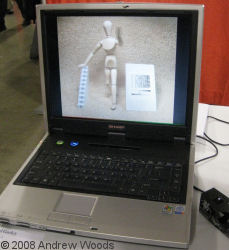 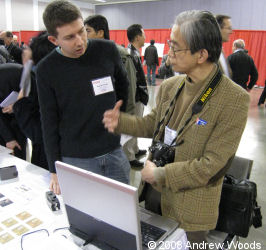
| |
[15a,15b] Paul Gorley and Nick Holliman from the University of Durham (Durham, United Kingdom) demonstrated a human visual system based, stereoscopic image quality metric for compression of stereoscopic images. Sample images were shown on a Sharp RD-3D autostereoscopic laptop.
|
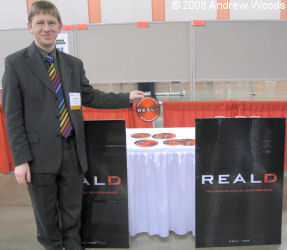
| |
[16a] REAL D (Beverley Hills, California) had a table loaded with give-away "REAL D - The Premier Digital 3D Experience" stickers.
|
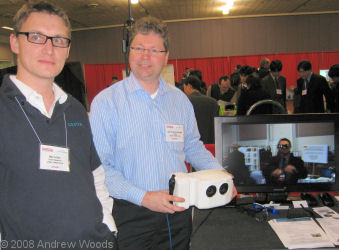 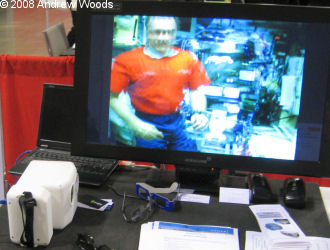 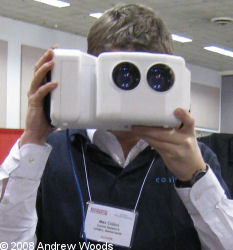
| |
[17a,17b] Massimo Sabbatini from the European Space Agency (Noordwijk, Netherlands) and Max Collon and Marco Beijersbergen from Cosine Research (Leiden, Netherlands) demonstrated the DSCC2000 digital stereoscopic camcorder with 720P resolution, in-build hard drive and stereoscopic view-finder. Live and pre-recorded video output from the camera was shown on a Miracube 24" 3D LCD - a micropolarizer-based stereoscopic display with 1920x1200 resolution, viewed with passive polarized 3D glasses.
|
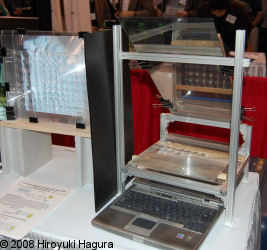 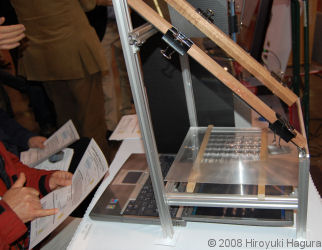
| |
[18a,18b] Hideki Kakeya from the University of Tsukuba (Tsukuba, Japan) demonstrated a coarse integral imaging autostereoscopic display, which, according to the accompanying paper, enables natural focal accommodation of the viewer.
|
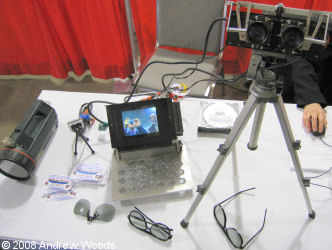 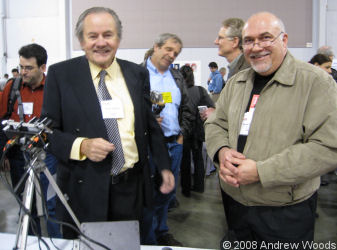
| |
[19a,19b] John Rupkalvis from Stereoscope International (Burbank, California) demonstrated a special lateral-shift stereoscopic video camera, a small passive polarized stereoscopic monitor, and a special parallax-indicating light. (Pictured: John Rupkalvis with Michael Brauss. In the background: Rob Engle, John Toeppen, John Roll).
|
[20] Chaio Wang from the University of Southern California (Los Angeles, California) demonstrated software for the interactive adjustment and manipulation of stereoscopic disparity in an image, using desktop and laptop PCs including a Sharp AL-3D autostereoscopic laptop.
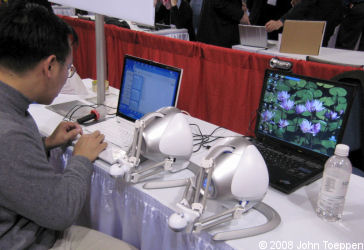 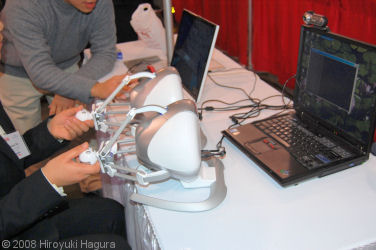
| |
[21a,21b] Alexander Sawchuk from the University of Southern California (Los Angeles) demonstrated a 3D interactive navigation device and a set of computer games to measure visual and motor characteristics of human subjects.
|
[22] Ianir Ideses from Tel-Aviv University (Tel-Aviv, Israel) demonstrated 3D images and spatially produced depth maps using 3D visualization devices.
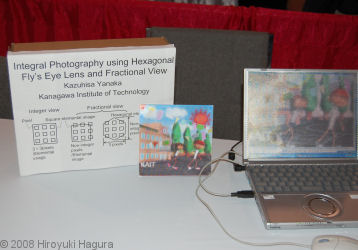 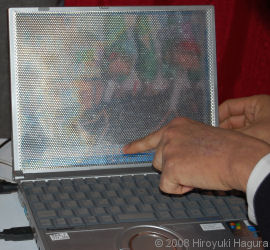
| |
[23a,23b] Kazuhisa Yanaka from Kanagawa Institute of Technology (Kanagawa, Japan) demonstrated how full parallax is obtained by piling up one of two kinds of hexagonal fly's eye lens sheets on an LCD monitor of a PC.
|
[24] John Dammann from the Army Research Laboratory (Adelphi, Maryland) demonstrated a stereoscopic visualization of electrostatic charges moving around a helicopter in flight on a Sharp RD3D autostereoscopic laptop. The motion of the blades causes the flow of charges, and the interactive visualization allows the user to zoom, pan and control the blade motion.
In parallel with the demonstration session, the 16 SD&A conference poster authors presented their posters in the symposium-wide poster session. The full papers from the poster session are contained in the SD&A conference proceedings.
Electronic Imaging Exhibition
In addition to the demonstration session, stereoscopic products were also on display in the exhibit area on Tuesday and Wednesday:
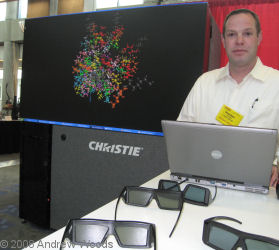 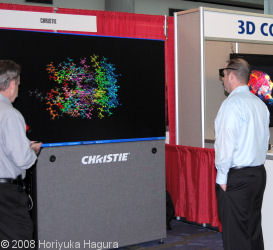
| |
[25] Wayne Bickley and Doug Boyer from Christie Digital (Cypress, California) demonstrated the "HD Mobility" - a full high-definition 80" rear-projection stereoscopic display based on the use of a Mirage HD3 Active Stereoscopic three-chip DLP Projector with 2,800 ANSI Lumens. The display was viewed using the new NuVision Cinema LCS 3D glasses, and 3D content shown on the display included 3D stills and interactive stereoscopic models of protein molecules, using a molecular modeling program called VMD from the University of Illinois.
|
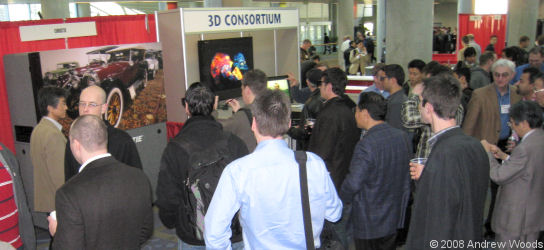
| |
[26] The 3D Consortium (Japan) facilitated the exhibition of stereoscopic products from several 3D Consortium member companies:
|
| | 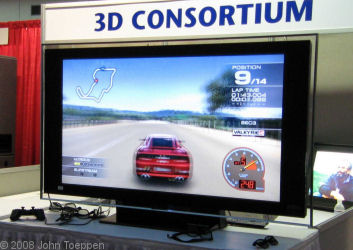 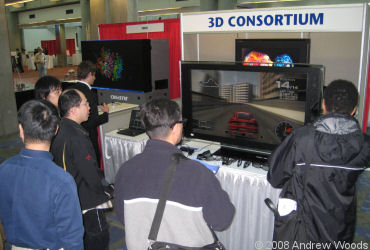
| |
[27a,27b] Atsushi Miyazawa and Motonaga Ishii from Namco Bandai Games (Tokyo, Japan) demonstrated a stereoscopic version of Ridge Racer 7 running on a PlayStation 3 and viewed with circularly polarized 3D glasses. The game was displayed on a 46-inch Sony Bravia HDTV equipped with a micro-polarizer filter technology from Arisawa (Japan) with the cooperation of NHK Technical Services (Japan).
|
| | 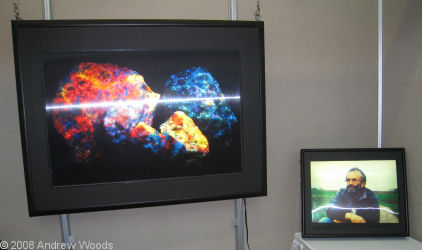
| |
[28] David Mark from Mark Resources (San Francisco, California) demonstrated a 60" diagonal full-color autostereoscopic 3D backlit transparency print of fluorescent minerals.
|
| | 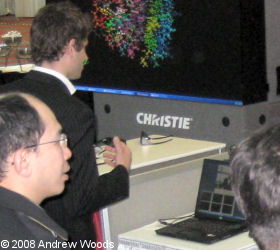
| |
[29] Shaun Cotter from Seeing Machines (Canberra, Australia) demonstrated "faceAPI" software for automatic head and face tracking and measurement.
|
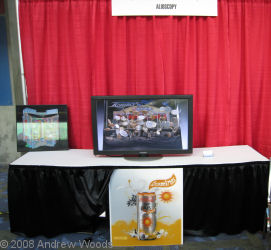 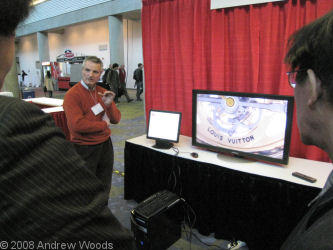
| |
[30] David Pepy and Philippe Roche from Alioscopy USA (San Diego, California) demonstrated the 40" Alioscopy autostereoscopic 3D display which provided 8 views and is based on a full-HD LCD HDTV. 3D content shown included 3D CGI and 3D live-action footage. Also displayed were some 3D Alioscopy posters giving examples of client work.
|
Also in the exhibit area, the annual Phantogram Exhibit was organized by Terry Wilson from Terryfic3D.
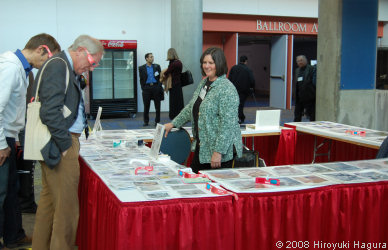 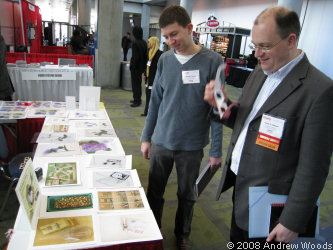 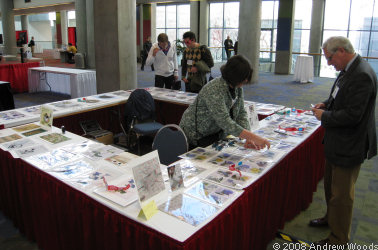
| |
[31a,31b,31c] As well as showing a vast collection of Terry's own 3D phantograms, the exhibit included works from the following phantogram artists: Sam Paechter (UK), Takashi Sekitani (Japan), and Barry Rothstein (USA).
|
|

